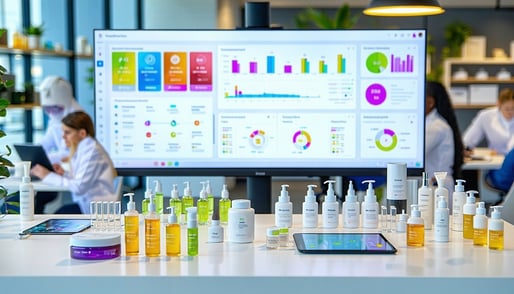The most important thing in a cosmetic product development is to have two key documents ready: the Product Information File (PIF) and the Cosmetic Product Safety Report (CPSR). Let’s talk about the main parts of each document and the information needed to meet safety rules.
What is Product Information File (PIF)
The Product Information File (PIF) is a crucial compilation of data and documents required by regulations. It is created after a cosmetic product is launched on the market, mandating the information’s availability to the competent authorities at the Responsible person’s address. It is mandated by regulatory bodies like EU (Article 11 of the EU Cosmetics Regulation No 1223/2009) and FDA Modernization of Cosmetics Regulation Act of 2022 (MoCRA), the PIF ensures product traceability, and of course safety and compliance.
The PIF must be in electronic or handwritten format, kept for ten years, and include product details, safety reports, GMP-compliant manufacturing info, test results, ingredient data, and animal testing details in the local language. Authorities and the public can access relevant information if concerns arise.
Similarly, MoCRA, though not explicitly mentioning the term "PIF," enforces similar requirements for maintaining records of products, ingredients, safety validation, and adverse events.
These regulations cover the PIF's essential function in providing authorities with accessible product safety data, facilitating market surveillance, and ensuring consumer protection.
Key Components of the PIF
The Product Information File (PIF) is structured to provide a comprehensive and traceable record of a cosmetic product's journey right from ideation to market. The following key components are essential for a PIF:
-
Product Identity: Defines the product's unique identity with its name, code, intended use, and target audience.
-
Manufacturer Information: Provides critical contact and registration details for the Responsible Person and manufacturer.
-
Product Composition: Lists all ingredients with INCI names and concentrations for formulation transparency.
-
Cosmetic Product Safety Report (CPSR): Contains a safety assessment by a qualified assessor, validating product safety.
-
Product Claims and Efficacy: Presents evidence supporting all marketing claims about the product's effectiveness.
-
Product Testing and Analysis: Documents all testing data ensuring product quality and safety.
-
Packaging, Labelling, and Instructions: Confirms regulatory compliance and provides clear consumer guidance.
-
Product Information Updates: Tracks all changes to the product formulation over time.
-
Data on Animal Testing: Documents any prior animal testing, ensuring ethical and regulatory adherence.
What is the CPSR?
The Cosmetic Product Safety Report (CPSR) is the proof of a cosmetic product's safety substantiation, also serving as the scientific assessment that demonstrates compliance with Article 3 of the EU Cosmetics Regulation (EC) No 1223/2009.
As mandated by Article 10, prior to placing a cosmetic product on the market, the Responsible Person must ensure a thorough safety assessment has been conducted and a CPSR has been put together, based on relevant information and in accordance with Annex-I. Again, this report is not a formality; it is an evaluation of the product's safety profile, considering the intended use and anticipated systemic exposure to individual ingredients. The assessment employs a weight-of-evidence approach, reviewing data from all available sources to determine the product's safety. The CPSR must be kept up-to-date, reflecting any new relevant information generated post-market.
As specified by Article 10(2), the safety assessment, outlined in Part B of Annex I, must be conducted by a qualified professional holding a diploma in pharmacy, toxicology, medicine, or a related discipline, ensuring that the safety evaluation is performed by a competent expert.
Structure of the CPSR
The Cosmetic Product Safety Report (CPSR), as mandated by the EU Cosmetics Regulation, is structured into two distinct parts, each addressing important aspects of product safety:
PART A: Cosmetic Product Safety Information
This section serves as a collection of all relevant data concerning the cosmetic product. It covers:
-
Quantitative and qualitative composition of the product: A detailed list of all ingredients and their concentrations.
-
Physicochemical characteristics and stability: Information on the product's physical and chemical properties, as well as its stability over time.
-
Microbiological quality: An assessment of the product's microbial content, to ensure microbiological safety.
-
Impurities, traces, and information about the packaging material: Data on any potential contaminants and the suitability of the packaging material.
-
Normal and reasonably foreseeable use: A description of how the product is intended to be used and any reasonably foreseeable misuse.
-
Existing data on the cosmetic product: Any pre-existing safety data or studies.
PART B: Cosmetic Product Safety Assessment
This section presents the expert evaluation of the data provided in Part A, concluding with a safety assessment:
-
Conclusion of the safety assessment: A clear statement of the product's safety for human use under normal and reasonable conditions.
-
Labelled warnings and instructions for use: Recommendations for any necessary warnings or instructions for safe use.
-
Reasoning behind the safety assessment: A detailed explanation of the reason behind the safety assessment, including the weight-of-evidence approach.
-
Assessor's approval: Documentation of the safety assessor's approval of the assessment.
This section is completed following the SCCS (Scientific Committee on Consumer Safety) notes of guidance, to ensure the report is created to the highest standard.
Regulatory Compliance and Launch Preparation
Notifying the Cosmetic Product
Another important step in launching a cosmetic product is the mandatory notification process. This is achieved through the Cosmetic Products Notification Portal (CPNP), an online platform where the Responsible Person submits detailed information about the product before it is placed on the market. This notification includes the product's formulation, labelling, contact information, and the CPSR. The CPNP serves as a central database for competent authorities, enabling them to access essential product information for market surveillance and risk assessment. Successful notification is a prerequisite for legal market placement, ensuring that regulatory bodies are aware of the product and its safety profile.
Preparing for Market Surveillance
Competent authorities within the EU conduct market surveillance to ensure compliance with cosmetic regulations. This can involve inspections of manufacturing facilities, audits of PIF and CPSR, and sampling of products for laboratory analysis. Manufacturers and Responsible Persons must be prepared for these potential interventions, as proactive preparation for market surveillance demonstrates a commitment to product safety and regulatory compliance.
Utilising the Documents from the EU Documents Room
The European Commission provides a wealth of resources through its documents room, accessible online. These resources include guidelines, regulations, scientific opinions, and best practice documents. Manufacturers should actively utilise these resources to ensure a thorough understanding of regulatory requirements. Accessing and implementing the documents from the EU documents room allows for the development of accurate PIFs, CPSRs, and overall compliance strategies. This approach ensures that cosmetic products meet the highest safety and regulatory standards, promoting consumer confidence and facilitating smooth market access.
Technological Challenges and Solutions
Managing extensive cosmetic portfolios with hundreds or even thousands of products brings significant technological challenges. Each product requires a separate PIF and CPSR, resulting in a massive volume of documents. Manually handling and updating these files is not only time-consuming but also prone to errors, risking non-compliance with the ever evolving regulations. This complexity demands a streamlined and automated system for efficient document management. A modern PLM solution offers a centralised platform to efficiently organise, track, and update PIFs and CPSRs, ensuring compliance and reducing administrative burden.
Looking to simplify your PIF and CPSR management? Discover smarter, faster, and compliant solutions with Plevenn.
Conclusion
The Product Information File (PIF) and Cosmetic Product Safety Report (CPSR) are vital for a successful and compliant cosmetic product launch, ensuring consumer safety and regulatory compliance under Regulation No 1223/2009. Prioritising safety following regulatory guidelines is of utmost importance for building trust and ensuring market longevity.
April 8, 2025



